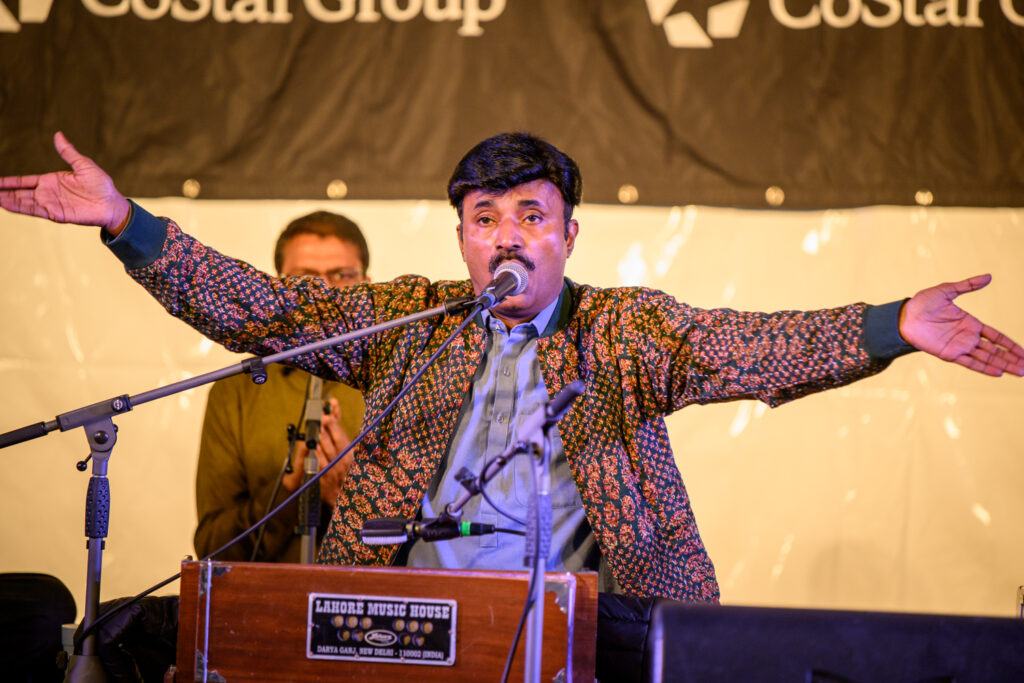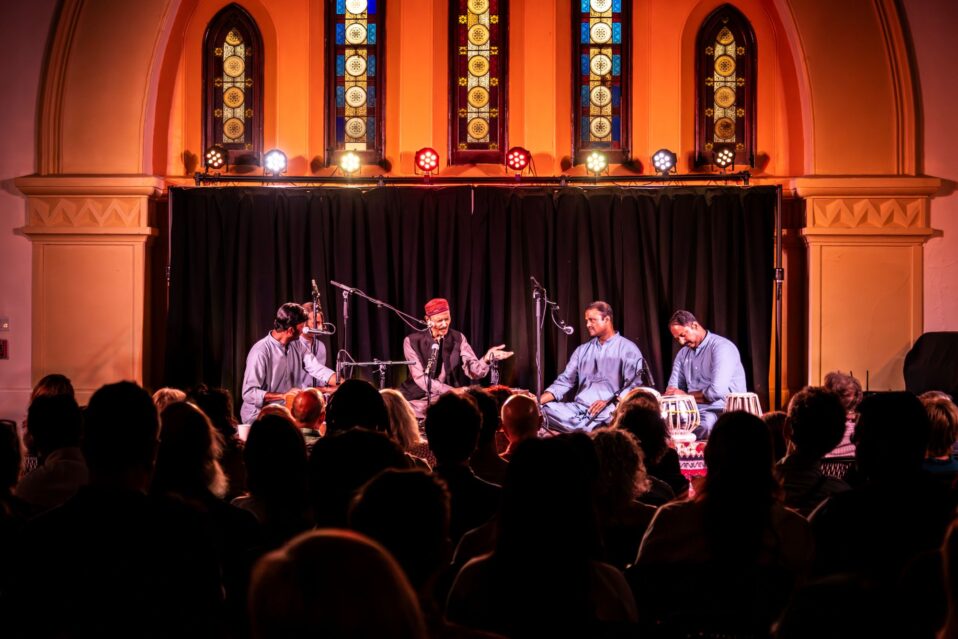“Our Ustaads were not just teachers—they were mentors, friends, and caregivers.” —Residency Participant, NYC 2025
When we first met the Saami family, we stepped into a living tradition that has carried the breath of imagination for nearly 800 years. The art of Khayal—meaning “imagination”—is among the oldest forms of Hindustani vocal improvisation, passed carefully from master to student, generation to generation.
Through our partnership with the Saami family, the Center for Cultural Vibrancy (CCV) has had the rare privilege of helping this profound musical tradition find new resonance—across borders, generations, and hearts. And most importantly, CCV is supporting the Saami family’s own vision and hopes for their traditions’ future. (Photo above by Lopez Art Photography.)
What Are Khayal and Qawwali — and Why Do They Matter?
Khayal is more than a style of singing; it’s a philosophy of attention. Largely wordless and deeply meditative, it draws on Turkish, Persian, Arabic and Indian roots. The singer moves through a raag (a framework of notes and moods), crafting improvised melodies that evoke emotion and transcendence.
The Saami family, direct descendants of a venerable gharana (lineage) of South Asian music, are among the last masters able to render Khayal’s 49‑note microtonal scale with stunning precision.
The family also performs Qawwali—the Sufi devotional vocal music of South Asia. Some of their live U.S. performances have featured Qawwali alongside Khayal, offering young audiences a broader spectrum of ancient South Asian soundscapes.
Through both Khayal and Qawwali, the Saami family invites not just listening, but transformation.
Phase 1: Building a Bridge in Lahore

In 2023, we leveraged an existing friendship between CCV’s Josh Kohn, Pakistani pop artist Zeb Bangash and Dr. Homayra Ziad of Johns Hopkins University to launch a five‑week Healing Khayal program in Lahore, Pakistan.
Students gathered in person to study directly with the Saami family—exploring not only the technical intricacies of Khayal, but also its spiritual depth.
What we learned was profound: there is a hunger among young Pakistanis to reclaim this nearly lost tradition.
Phase 2: Khayal & Qawwali Find New Life in New York
In winter of 2025, the spark crossed oceans.
With the help of longtime Saami‑family student and now U.S. Director of Strategy & Residencies with the Saami family, Nermeen Arastu, CCV welcomed Ustad Saami and his sons to New York for a six‑week residency we called Khayal as Cure.
From a large pool of applicants, 21 were accepted. Each student paid on a sliding scale, and spent up to sixteen hours a week immersed in learning in small “Sur groups,” one‑on‑one with the Ustaads, and through solo practice.
The setting was intimate and intense, taking place in an Airbnb that doubled as both home and classroom. Students came and went throughout the day, meals were cooked and shared, songs were born, and something extraordinary happened—an authentic master‑apprentice relationship took root in the heart of New York City.
“I discovered a voice I didn’t know I had. Singing has become a grounding force in my life.” —Residency Participant, NYC 2025
These lessons were about more than the music; they built community, courage, creative freedom and new cultural roots.Outside the classroom, the family brought their art to the public—performing Khayal and Qawwali at Barzakh Café, local studios and small venues across the city. Slowly, a new following emerged: young, curious, and utterly captivated.



Phases 3 & 4: A Living Tradition on Tour
From there, the Saami family’s journey expanded nationwide.
CCV supported performances and workshops at some of America’s most respected venues, including Wolf Trap, World Music Institute, Richmond Folk Festival, Seattle Town Hall, Flushing Town Hall, Ragas Live — and soon Globalfest at Lincoln Center, Big Ears Festival, and more.
Nearly every performance sold out. Some of the performances were only the family’s style of very traditional Qawwali, Some were pure Khayal-the first time long‑form Khayal of this caliber had been presented in the United States.


While the performances of both Khayal and Qawwali in the U.S. differ in certain ways from what you would historically find in Pakistan, what is emerging is a new type of cultural transmission—one in which second‑generation South Asians and other young Americans are finding a home for these ancient sounds. Tradition isn’t simply preserved; it’s reinvented.
What We’ve Learned Along the Way
Our work with the Saami family has reinforced for us the notion that tradition thrives not through preservation alone, but through participation and evolution. Some of our biggest take‑aways:
- Structure and accessibility matter as much as inspiration.
- Facilitators are vital for bridging cultural and logistical gaps.
- There is a global hunger for authentic, lineage‑based arts when presented with care and respect.
- The power of art to heal lies in the lived experience.



The Future of Healing Khayal & Qawwali
CCV is committed to deepening this work in the coming years. With a multi‑year P3 visa secured for the Saami family, we’re planning new residencies, performances, and educational outreach.
We’re also proud to share that Ustad Saami is a recipient of the prestigious Aga Khan Music Awards 2025— including the Patron’s Award alongside his sons—in recognition of the Saami musical lineage’s extraordinary contribution to South Asian musical heritage. The awards honor “individuals, groups and institutions whose work sustains and reimagines living musical heritage shaped by Islam while promoting spiritual insight, community vitality and cultural resilience.”
Ustad Saami—once regarded as perhaps the last living master of Khayal in Pakistan—now stands surrounded by students, sons, supporters and now a growing diaspora community carrying his vision forward. We are witnessing a cultural inflection point: a living legacy being passed from master to master, generation to generation.
Why It Matters
At CCV, we believe that cultural survival is not about simply looking backward—it’s about staying alive in the present. The story of Healing Khayal (and Qawwali) shows how tradition and innovation, past and present, can meet in one resonant note. Together with the Saami family, we’re helping ensure that this ancient art continues to sing—not from a museum, but from the soul.





